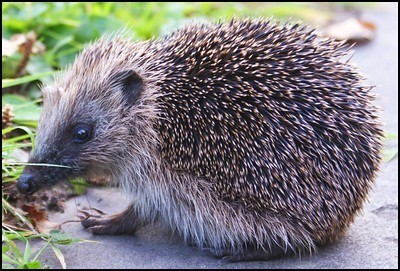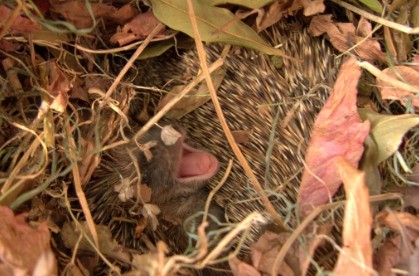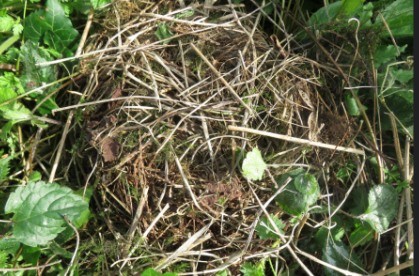A hedgehog nest looks like a collection of leaves, grass, and other plant materials — arranged loosely in the summer and much more tightly in the winter.
Hedgehogs are not only known for their spines, but their presence around gardens, trees, bushes, and of course, hedges. That being the case, hedgehogs have a distinct behavior of their own, making them much different from your pet cat or dog. Hedgehogs are not only nocturnal animals that rest during the day but animals who hibernate for months at a time — and will create nests for each instance. But what does a hedgehog nest look like? This article will explore hedgehog nests and nesting behaviors, and detail the appearance of hedgehog nests for all seasons.
Overview: About Hedgehogs

Hedgehogs are members of the family ERINACEIDAE (subfamily ERINACEINAE). There are seventeen known species of hedgehogs worldwide — and they are native to the continents of Asia, Europe, and Africa (they are an introduced species to New Zealand, and are kept as pets elsewhere).
For our purposes, we will only discuss the nesting habits of the European Hedgehog (ERINACEUS EUROPAEUS), an animal that is found in much of Europe and in Great Britain. This hedgehog is likely the largest species of hedgehog, weighing 2.4 to 4.4 pounds and reaching 10 inches in length (or more).
The European Hedgehog (we will refer to it as the “hedgehog”) is a nocturnal creature that has a fairly large range — about 10 to 20 hectares — and can travel 2 to 3 kilometers at night searching for food. It also is a hibernating animal, resting in a reduced metabolic state from November to March.
In the daytime, the hedgehog will take refuge in a nest to sleep — and at night, will come out to forage, build nests, mate, and feed. The hedgehog will also take to a nest during its breeding and hibernation periods, although these nests are somewhat different from their daily habitats.
Hedgehogs like to inhabit environments with plenty of plant cover, whether it is in the underbrush, near hedges, trees, bushes, shrubs, or in gardens. It is here that they search for food (mostly invertebrates) and look for plant materials to build their nests.
Because the hedgehog population has suffered a severe decline in the UK in recent decades (down from an estimated 30 million in the 1950s to around 1 million today), people have attempted to help hedgehogs through artificial nests.
Although artificial nests are constructed out of different materials (brick, wood, plastic) than natural hedgehog nests, some of the building principles are the same. A hedgehog may line its nest with dried grass or leaves, for example, something artificial nest builders are encouraged to do.
What Does A Hedgehog Nest Look Like
A hedgehog’s nest is constructed generally for three purposes: to sleep in during the day, as a place to raise young, and as a place for hibernation. There may be some overlap in construction (as daytime nests are similar to nests for hedgehog babies [hoglets]) but this is essentially the case.
Broadly speaking, hedgehog nests can be divided into those used in the spring and summer months, and those used during the winter hibernation period. This is due to the different weather conditions, and the fact that a hibernating hedgehog requires a very different nest for winter conditions.
Summer Nests
In the spring and summer, a hedgehog will build a loosely constructed nest out of leaves, grass, moss, twigs, and similar plant materials. These nests will naturally be a few times larger than the hedgehog itself and will often have a main hole or opening in which the hedgehog will enter/exit.

These summer nests will look like piles of leaves, twigs, or grass (depending on the materials around) or a combination of these materials. For this reason, summer hedgehog nests will resemble loosely raked leaf piles or the foundations of bonfires.
The nests are loosely constructed to keep the hedgehog cool during the daytime — when it is sleeping. In a similar fashion, a hedgehog may just take to long grass as a nesting area during the summer.
Because a hedgehog’s summer nest often resembles raked leaves, tall grass, or compost piles, extra precautions are often given to garden owners — who may want to clean their yards or gardens, inadvertently disrupting the hedgehog’s place of rest during the day.
Breeding Nests
Nests built by a hedgehog mother who is anticipating hoglets will be of similar construction, albeit somewhat larger, to accommodate the mother and her litter of some four or five hoglets. The construction of these “breeding” nests will begin in the month of May.
Breeding nests notably have a more carefully laden construction — they will be dutifully lined with grass in comparison to their daily or hibernation nests. This, incidentally, is a feature that some artificial nests attempt to emulate.
Mother hedgehogs, in addition to birthing a spring litter, may give birth to another litter in the fall. This necessitates the construction of another breeding nest, though fall litters may not be as carefully raised as those birthed in the spring.
Winter / Hibernation Nests
Since a hedgehog undergoes a winter hibernation period, the question “what does a hedgehog nest look like?” does not really have an all-applicable answer. The winter hibernation nests are specifically made to handle winter temperatures and weather conditions.

These winter nests are also known as HIBERNACULA and are notably stronger and more durable than their summer counterparts. Hibernacula are roundish dwellings some two feet in diameter and are noted for having tightly woven walls with a thickness of several centimeters.
The hibernacula are noted for their construction, consisting of twigs, grass, moss, bark, and leaves that are heedfully placed to make an insulated, waterproof shelter.
Hedgehogs ideally hibernate at temperatures between 1 and 4 degrees celsius (34 to 39 degrees Fahrenheit). This is because hedgehogs need temperatures high enough to be above freezing and low enough to optimize their hibernating metabolism.
As such, hibernacula have been recorded as having very stable temperatures. One study (Morris, 1973) of hedgehog nests in Bushy Park, London, noted that despite temperatures from -8 to 10 degrees Celsius (17.5 to 50 degrees Fahrenheit), hibernacula stayed at 1 to 5 degrees Celsius (34 to 41 degrees Fahrenheit).
The same study found that the average hibernacula lasted about 6.4 months. About half of the nests studied lasted less than five months, with some nests lasting more than 12 months.
Hedgehog Hibernation And Hibernacula Materials
Hedgehogs, for the most part, begin building their nests in October and November. They will begin to hibernate in November, or if the season is relatively warm, start to hibernate in early December.
Their choice of nesting material — for the slightly less than 20 centimeter-thick walls, at least — appears to be closely packed deciduous leaves. Morris writes that Sycamore and Turkey Oak were the least preferred leaves.
The hibernacula are some 30 to 60 centimeters in diameter and can be occupied by several hedgehogs at once — though this is not too common. By January, the hedgehog is in a fully hibernating state but may awaken if the weather is warm for a significant period of time.
By February, the hedgehog will still be in a somewhat solidly hibernating state. Hedgehog nests –including hibernacula — will degrade over the winter due to heavy snow, rain, or other precipitation, even more so if they are constructed primarily out of grass.
It should also be noted that hedgehogs will build hibernacula under bramble, hedgerows, and under similar natural spaces. The nests that are built under these organic structures tend to last longer (over 7 months on average), as they protect the nest from decomposition.
By March, the hedgehogs will emerge from the hibernacula and will have lost a significant amount of weight. They will be hungry and thirsty and look for food and water immediately. The hedgehog is likely to build new nests, including hibernacula, over time, repeated use is quite uncommon.
ARTIFICIAL NESTS
At least part of explaining the appearance of hedgehog nests should include those made by humans. Humans can and have made hedgehog nests that are made of various plastic, wooden, stone, or brick materials (lined with grass or leaves), and these may be used as daily or winter nests.
This practice is increasingly common as rural hedgehog populations are severely declining in countries like the UK. As more hedgehogs are becoming common in the cities and suburbs, more people are taking to using artificial nests to accommodate them.
If you’re interested in establishing a hedgehog house yourself, here is what I’ve found out about hedgehog habitats, do-it-yourself hedgehog home construction, and the top 5 hedgehog house best buys around.
CONCLUSION
If you have ever wondered “what does a hedgehog nest look like?”, you are likely not alone. Hedgehog nests, despite their standard component materials (leaves, grass, straw, etc.) may differ from season to season and from purpose to purpose.
But the most common appearance in hedgehog nests is that they tend to appear as loosely packed piles of plant materials in the summer, and much more solidly packed piles of similar materials in the winter. With this in mind, you can carefully look out for hedgehogs should you happen upon their nesting homes.
